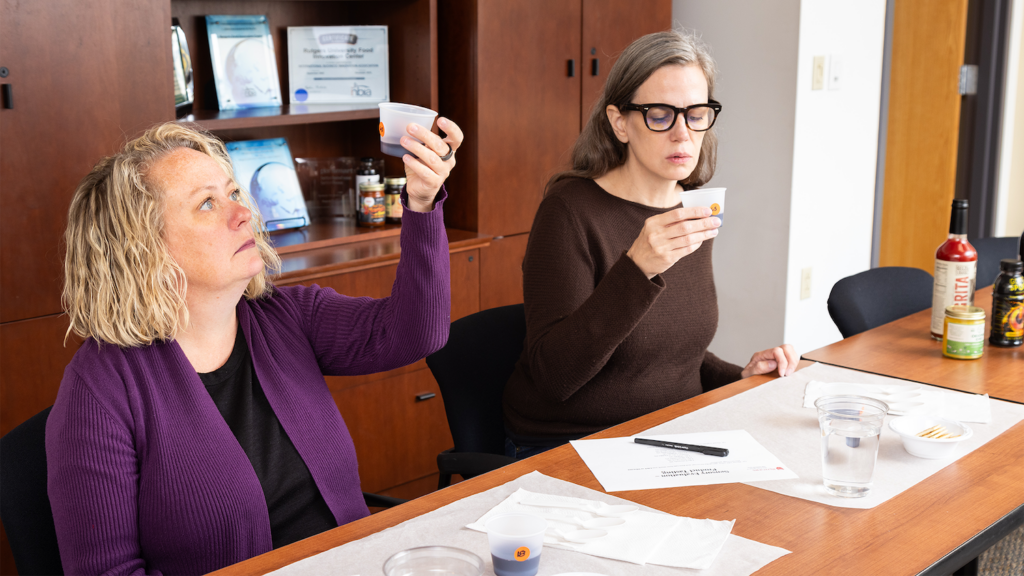Main Content

At the Food Innovation Center at Rutgers (FIC), we always remind our clients that the product has to taste great.
The International Food Information Council has been conducting an annual Food and Health survey for over a decade. This year, they surveyed 3000 consumers, and found 85% of them ranked taste as the most important element in their food and beverage purchase decisions.
Taste and flavor are terms used interchangeably quite often, but not everyone realizes there is a difference between the two. Taste happens mainly in the mouth on the taste buds, and the five basic taste sensations are sweet, salty, sour, bitter and umami.
Although taste is an important component of flavor, flavor also includes the aroma. Some research shows that aroma can account for up to 80% of how people perceive the flavor (source: University of Florida Central Center for Smell and Taste, “Taste vs. Flavor: What’s the Difference” blog, May 5, 2015).
There are several ways to conduct product tastings. At FIC, we conduct sensory evaluations. This is defined as a scientific method used to evoke, measure, analyze and interpret those responses to products as perceived through the senses, sight, smell, touch, taste, and hearing (source: Stone, H. and Sidel, JL, 1993. Sensory Evaluation Practices, 2nd edition, Academic Press: San Diego). Sensory evaluations are typically used to understand how consumers perceive and respond to the products, and also to identify how to improve or optimize the product.
The main types of sensory evaluation tests are: discrimination, descriptive and acceptance testing. The different test methods are described below:
- Discrimination Testing determines if there are perceived differences between the products. We might use this if a company is making a change to the product formulation — like an ingredient substitution — and wants to know whether consumers can detect these changes.
- Descriptive Testing measures the perceived characteristics and the relative quality and intensity of the sensory attributes. This can provide helpful guidance when developing a new product.
- Acceptance Testing measures the appeal and acceptance of a product. If launching a new product into the market, this type of test can provide direction on purchase interest, whether people like it, etc., as well as diagnostic information about the product attributes.
Since sensory evaluation is a scientific method, it is important to follow certain protocols for testing. These are some of the recommended guidelines.
- Evaluate the product in an environment that is quiet and not distracting. Often the panelists evaluate product in separate booths, or sometimes partitions are used.
- Panelists evaluate the product themselves. During the evaluation, there’s no sharing of opinions among participants. Discussions only happen after the evaluation is completed.
- Products are typically evaluated blind, meaning the product brand, name or package is not part of the test. This eliminates any potential bias, and allows participants to focus on evaluating the sensory attributes of the product.
- Palate-cleansing items are available after each sample so that the panelists can continue to effectively evaluate the product. Water is always good, but depending upon the type of product (i.e. high fat, high spice), additional palate cleansers may be required.
- Other factors to consider include the tasting order, the temperature to serve the products and making sure that all the product samples are consistent.
FIC offers sensory evaluations as part of the services and capabilities that can be provided, with our internal team providing directional feedback on the product. Our team consists of industry veterans with extensive experience spanning a broad array of disciplines, including research and development, culinary, innovation, market research, marketing, sales, manufacturing and operations, and quality assurance and food safety. Integrating the R&D team in the sensory evaluations helps to streamline the new product development process. The R&D team sees firsthand the formula revisions that are necessary to optimize the product; then they can then work directly with the client to make the necessary revisions.

